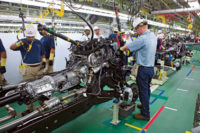A persistent theme in the business press is the presence of a skills gap in America. Thousands of U.S. manufacturing jobs are unfilled because there are simply not enough qualified workers.
But is that true? A new study suggests that demand for higher-level skills in U.S. manufacturing jobs is modest. In fact, three-quarters of U.S. manufacturing plants show no sign of hiring difficulties for open positions, according to researchers Andrew Weaver, a professor of labor and employment relations at the University of Illinois, and Paul Osterman, a professor of human resources and management at the Massachusetts Institute of Technology.
“Not a week goes by without someone declaring that a huge skills gap exists in the U.S. workforce,” says Weaver. “But [that claim is] frequently without evidence. The popular sentiment encourages people to think that employers have high skill demands, but U.S. workers just aren’t up to snuff, and that’s why manufacturing work is being outsourced overseas.”
However, the researchers found that U.S. manufacturers are generally able to hire the skilled workers they seek. “We estimate an upper bound of job vacancies due to a potential skills gap of 16 to 25 percent of manufacturing establishments—a finding that sharply contrasts with…reported figures of more than 60 to 70 percent,” Weaver says.
Why the difference? The researchers say current methods for determining a skills gap aren’t measuring the right variables and don’t account for geographic and industry dynamics. To get a clearer picture, they conducted their own survey that directly measures employer skill demands and hiring outcomes. The survey was sent to a random sample of 2,700 U.S. manufacturing establishments with at least 10 employees in late 2012 and early 2013.
The researchers wanted to measure what skills employers actually demand—particularly higher level skills—and they wanted to measure hiring difficulties that might imply a skills gap.
The researchers found that demand for higher-level math and reading skills is a significant predictor of long-term vacancies, but demand for computer skills and other critical-thinking or problem-solving skills is not.
Although the skills gap is cast purely as a shortage of science, technology, engineering and math skills, “it turns out reading also is a robust predictor of longer-term hiring difficulty,” says Weaver. “It certainly gives a more nuanced picture of skill challenges in manufacturing.”
To assess hiring difficulties, the researchers asked manufacturers about the number of job vacancies that have persisted for three months or more. They found that less than a quarter of manufacturers have at least one long-term vacancy. In addition, the researchers discovered that only 16 percent of establishments have long-term vacancies that amount to more than 5 percent of their total core workforce, and only 12 percent of plants have ever had to reduce production due to vacancies.
What do you think? Is there a skills gap? Read the report for yourself:
www.massbenchmarks.org/publications/issues/vol16i2/5.pdf.




